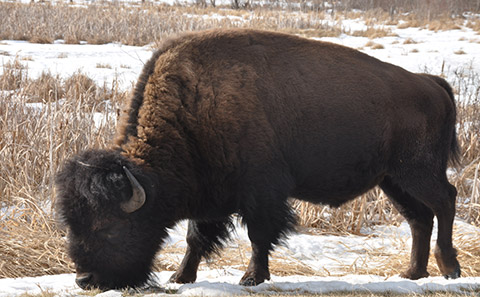Rewilding Arctic mammals unlikely to slow climate change impacts

A new study has shed new light on why large mammals died out at the end of the ice age, suggesting their extinction was caused by a warming climate and expansion of vegetation that created unsuitable habitat for the animals. The findings, published in the journal PNAS, have major implications for proposals to prevent the soils in the Arctic today from thawing by re-introducing animals such as bison and horses.
About 14,000 years ago, at the end of the last ice age, open, grassy landscapes that had extended eastwards from France across the now submerged Bering Sea all the way to the Yukon in Canada were transformed by the rapid spread of shrubs. At the same time, several iconic mammal species that inhabited what is now Alaska and the Yukon, such as the woolly mammoth, became extinct, and archaeology records human presence in the region.
These ancient coincidences have led to the suggestion that human hunting caused the demise of the mammals, and their loss led to the shrub expansion, as they were not there to trample down the vegetation and put nutrients back into the soil.
Today, with strong arctic warming, shrubs are spreading even further north into tundra regions. It is now popular to advocate that a form of rewilding - where animals are returned to their original ecosystems to restore more “natural” conditions - might reverse the trend of increasing shrub cover, with possible benefit of keeping carbon stored in the ground. This is because low-growing vegetation exposes the ground to colder conditions than shrub cover does, and thus the ground and the carbon it contains remain well frozen.
Others advocate that climate change drove the vegetation and landscape changes, and these led to the loss of the animals as their habitat disappeared.
To test these alternative hypotheses, an international research team examined records of fossil pollen preserved in lake sediments across Alaska and Yukon for thousands of years. By focusing on records that met strict dating criteria the team could accurately pinpoint the timing of shrub expansion across this region. They then compared this with how the numbers of radiocarbon-dated bones from horse, bison, mammoth and moose changed through time – which provided them with an estimate of their changing population sizes.
Their results showed that willow and birch shrubs began to expand across Alaska and Yukon around 14,000 years ago, when records of dated bones indicate that large grazing mammals were still abundant on the landscape.
“Our study uses a clear predictive test to assess two opposing hypotheses about large animals in ancient and modern tundra ecosystems: that the animals disappeared before the shrubs increased, or that the shrubs increased before the animals disappeared,” said Professor Mary Edwards of the University of Southampton who was part of the study team.
Dr Ali Monteath, the lead author from the Universities of Alberta and Southampton, adds “The results support the idea that at the end of the last ice age a major shift to warmer and wetter conditions transformed the landscape in a way that was highly unfavourable to the animals, including mammoths”.
The findings suggest that climate change was the primary controller of northern ecosystems and that the large herbivores were not able to maintain their environment as the shrubs spread. “While humans may have compounded population declines, our results suggest climate-driven vegetation change was the primary reason the mammals disappeared,” added Professor Edwards.
Returning to the concept of rewilding the North with large mammals that are currently absent from the region, the research team concludes that this would probably not transform the vegetation over large areas and so do little to curtail release of carbon from the Arctic permafrost.
Study co-author Professor Duane Froese of the University of Alberta said, “Re-wilding experiments at the scale of local paddocks, as has been done for example at Pleistocene Park (NE Siberia), show that megaherbivores can alter their environment, drive changes in vegetation and even cool soil temperature, but these animal densities are much higher than we would expect for Pleistocene ecosystems. Our study shows that the effect of megafauna grazing is small at sub-continental scales even with the presence of mammoths, and climate, once again, is the main driver of these systems.”
Benjamin Gaglioti of the University of Alaska-Fairbanks added “The hypothesis that reintroducing megafauna will prevent or slow warming-driven permafrost thaw and vegetation change in the Arctic has been bolstered by the idea that Pleistocene megafauna were instrumental in maintaining ice age ecosystems. In contrast to this prediction, our results show that high-latitude ecosystems responded sensitively to past warming events, even though megafauna were abundant on the landscape. These results lend support to the hypothesis that reintroducing megafauna today will do little to desensitize high latitude ecosystems to human driven warming.”